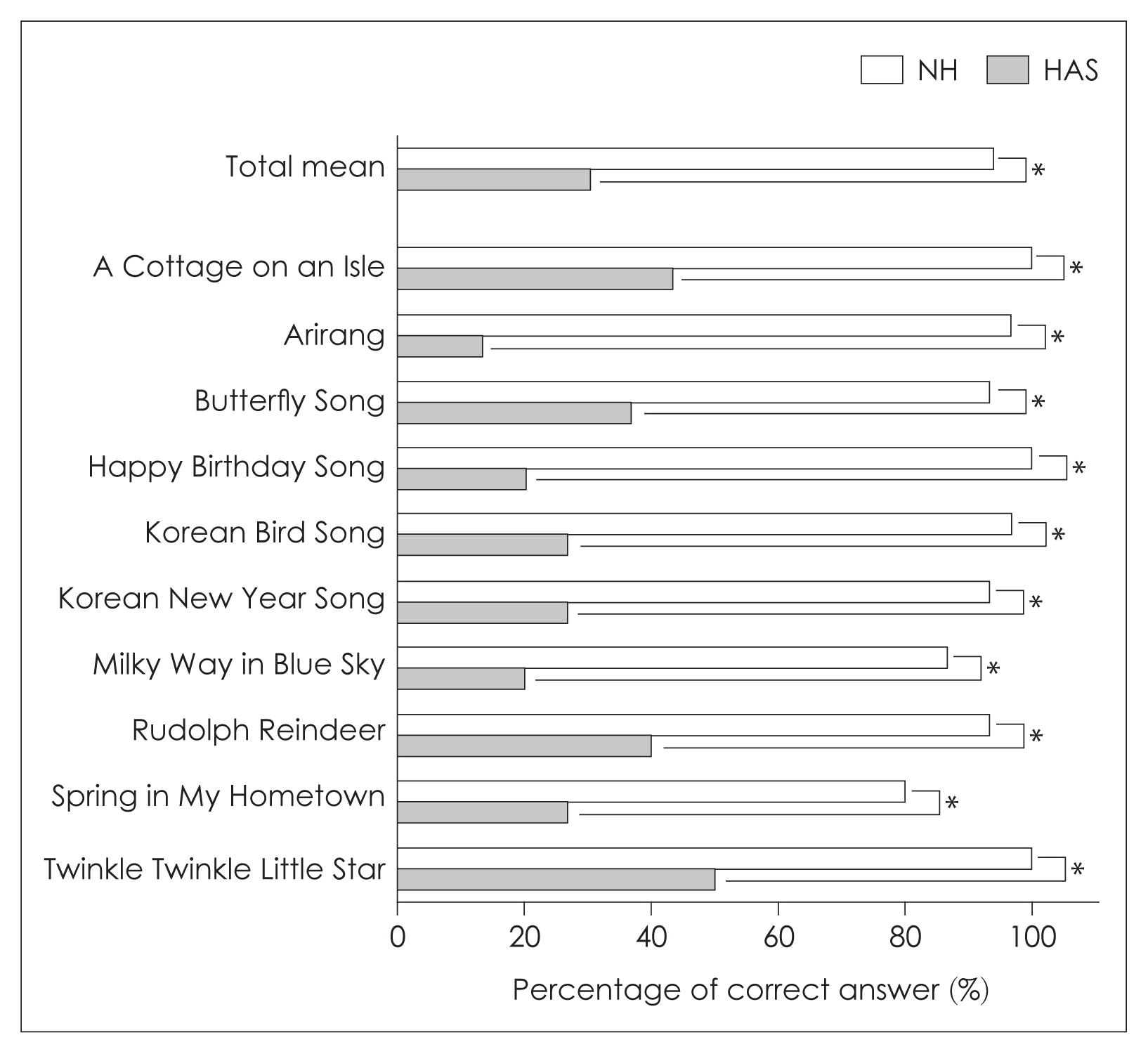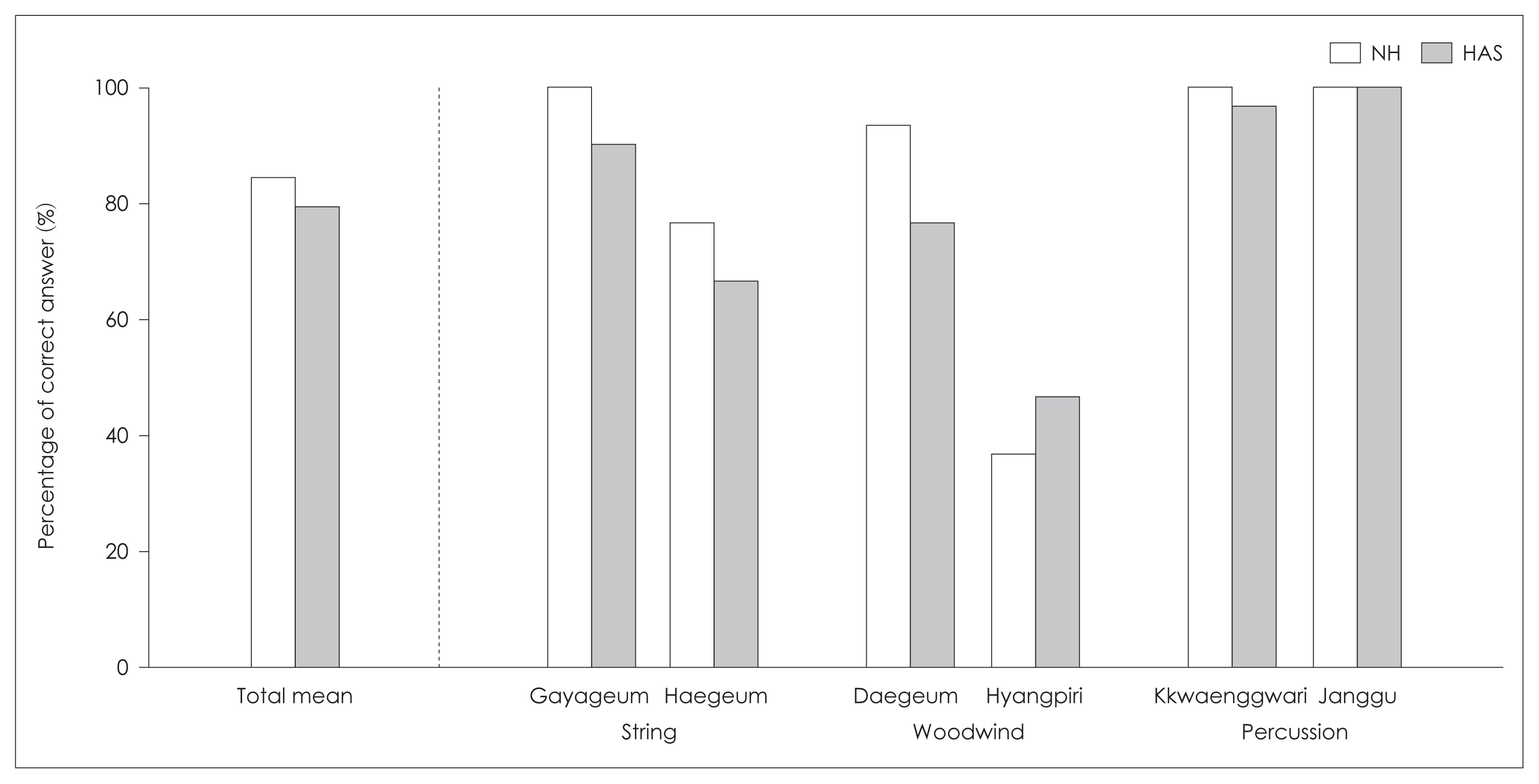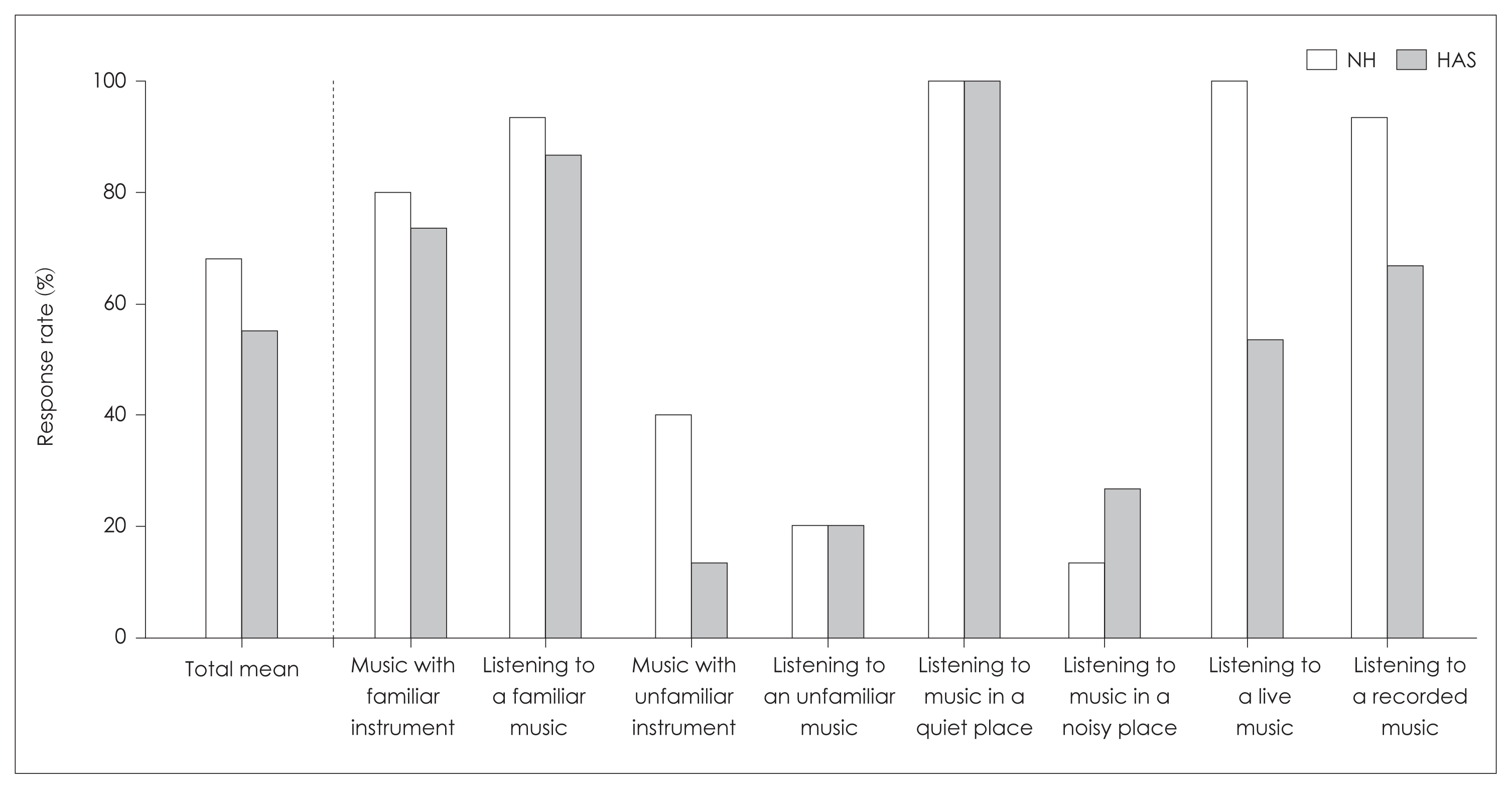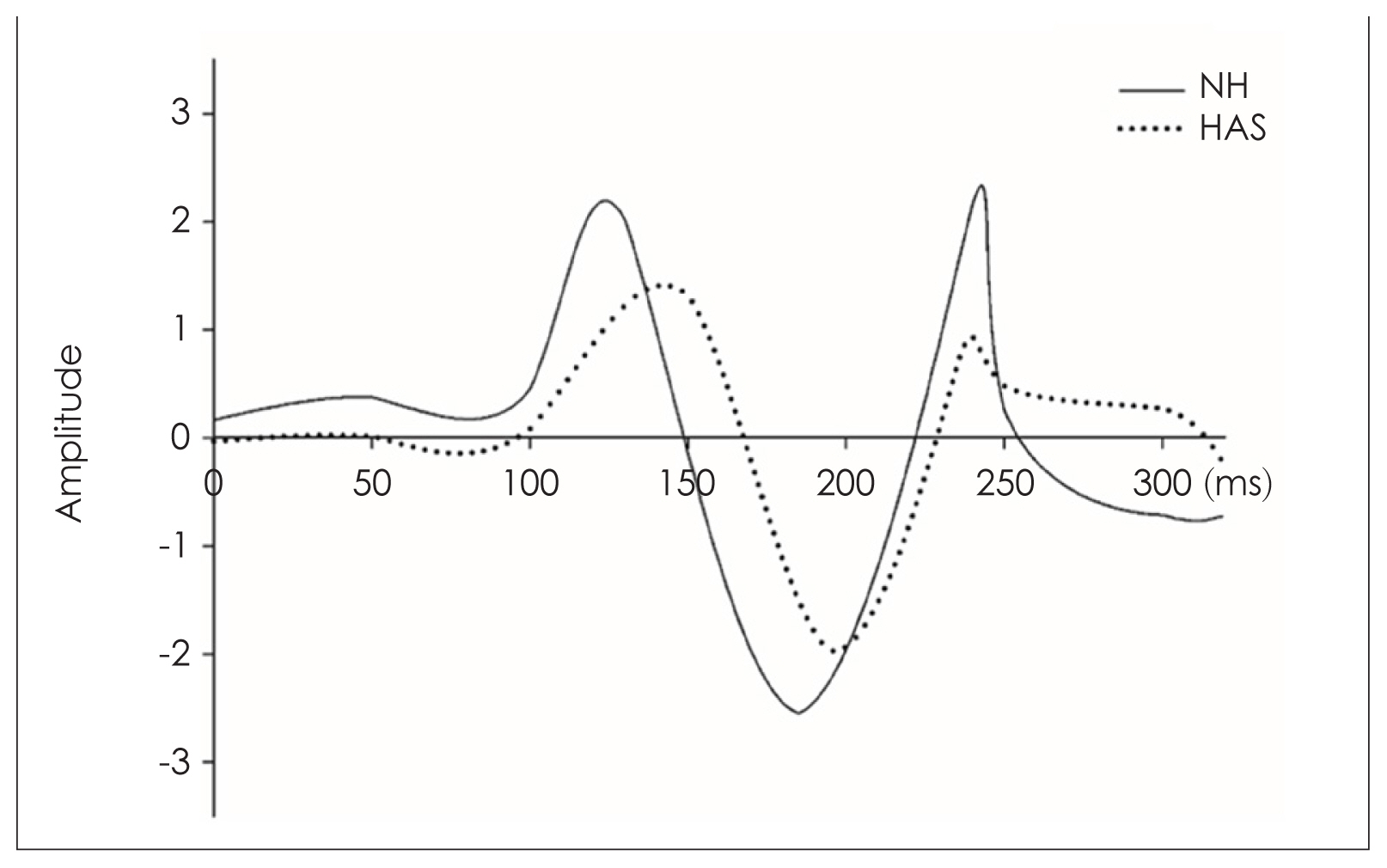1. Looi V, Gfeller K, Driscoll V. Music appreciation and training for cochlear implant recipients: a review. Semin Hear 2012;33:307ŌĆō34.

2. Darrow AA, Loomis DM. Music and deaf culture: images from the media and their interpretation by deaf and hearing students. J Music Ther 1999;36:88ŌĆō109.


3. Gfeller K, Christ A, Knutson J, Witt S, Mehr M. The effects of familiarity and complexity on appraisal of complex songs by cochlear implant recipients and normal hearing adults. J Music Ther 2003;40:78ŌĆō112.


4. Jung KH, Cho YS, Cho JK, Park GY, Kim EY, Hong SH, et al. Clinical assessment of music perception in Korean cochlear implant listeners. Acta Otolaryngol 2010;130:716ŌĆō23.


5. Moore BC, Sek A. Effects of carrier frequency, modulation rate, and modulation waveform on the detection of modulation and the discrimination of modulation type (amplitude modulation versus frequency modulation). J Acoust Soc Am 1995;97:2468ŌĆō78.


8. Sandmann P, Kegel A, Eichele T, Dillier N, Lai W, Bendixen A, et al. Neurophysiological evidence of impaired musical sound perception in cochlear-implant users. Clin Neurophysiol 2010;121:2070ŌĆō82.


9. Gordon E. The musical aptitude profile. Music Educ J 1967;53:52ŌĆō4.


10. Gordon EE. Developmental music aptitude as measured by the primary measures of music audiation. Psychol Music 1979;7:42ŌĆō9.


11. Fitzgerald D, Fitzgerald H, Brockmeier SJ, Searle O, Grebenev L, Nopp P. Musical sounds in cochlear implants (MuSIC) test. Innsbruck: MED-EL;2006.
13. Uys M, van Dijk C. Development of a music perception test for adult hearing-aid users. S Afr J Commun Disord 2011;58:19ŌĆō47.


14. Roy AT, Scattergood-Keepper L, Carver C, Jiradejvong P, Butler C, Limb CJ. Evaluation of a test battery to assess perception of music in children with cochlear implants. JAMA Otolaryngol Head Neck Surg 2014;140:540ŌĆō7.


16. Chin T, Rickard NS. The Music USE (MUSE) questionnaire: an instrument to measure engagement in music. Music Percept 2012;29:429ŌĆō46.


17. Shin Y, Yun J, Kyong JS, Jo S, Kim J. Development of assessment of music perception for the hearing-impaired. Audiol Speech Res 2021;17:331ŌĆō43.


18. Lee ES. A study for draft of assessment of music perception for hearing loss (AMPHL) test and application to cochlear implant users [masterŌĆÖs thesis] Chuncheon: Hallym Univ;2019.
19. Gfeller K, Lansing C. Musical perception of cochlear implant users as measured by the primary measures of music audiation: an item analysis. J Music Ther 1992;29:18ŌĆō39.

20. Looi V, McDermott H, McKay C, Hickson L. Music perception of cochlear implant users compared with that of hearing aid users. Ear Hear 2008;29:421ŌĆō34.


22. Gfeller K, Lansing CR. Melodic, rhythmic, and timbral perception of adult cochlear implant users. J Speech Hear Res 1991;34:916ŌĆō20.


23. Gfeller K, Woodworth G, Robin DA, Witt S, Knutson JF. Perception of rhythmic and sequential pitch patterns by normally hearing adults and adult cochlear implant users. Ear Hear 1997;18:252ŌĆō60.


25. Darrow AA. The role of music in deaf culture: deaf studentsŌĆÖ perception of emotion in music. J Music Ther 2006;43:2ŌĆō15.


26. Caldwell M, Rankin SK, Jiradejvong P, Carver C, Limb CJ. Cochlear implant users rely on tempo rather than on pitch information during perception of musical emotion. Cochlear Implants Int 2015;16(Suppl 3):S114ŌĆō20.


28. Caldwell MT, Jiradejvong P, Limb CJ. Impaired perception of sensory consonance and dissonance in cochlear implant users. Otol Neurotol 2016;37:229ŌĆō34.


29. Hyun SH, Yim D. The performance on degraded listening task in children with cochlear implants. Commun Sci Disord 2013;18:86ŌĆō97.

30. Hwang SY. A comparative study on music preference between schoolaged children with cochlear implant and normal hearing. Journal of Music and Human Behavior 2011;8:47ŌĆō64.
31. Kim HJ. Structure and function of the ear. The Korean Audiological Society. Practical Manual of Hearing Tests. 2nd ed. Seoul: Hakjisa;2009. p.21ŌĆō40.
32. Lee JH, Lee KW. Hearing aid evaluation and fitting. 2nd ed. Seoul: Hakjisa;2007. p.1ŌĆō448.
33. Han SL. Music preference and perceived complexity by genres of adults with cochlear implants in comparison with adults with normal hearing [masterŌĆÖs thesis] Seoul: Ehwa Womans Univ;2015.
34. Liang H, Wang J, Sun Q, Liu YJ, Yuan J, Luo J, et al. Barehanded music: real-time hand interaction for virtual piano. In: Proceedings of the 20th ACM SIGGRAPH Symposium on Interactive 3D Graphics and Games; 2016 Feb 27ŌĆō28; Redmond, WA, USA: ACM;2016 pp 87ŌĆō94.
35. J├żncke L. Music drives brain plasticity. F1000 Biol Rep 2009;1:78


38. Shin Y, Kyong JS, Jo S, Kim J. Development of Korean music rehabilitation program for persons with hearing loss. Audiol Speech Res 2022;18:83ŌĆō94.


39. Shin Y, Yu C, Jo S, Kyong JS, Kim J. A study of music training for cochlear implant users: mismatch negativity and music listening attitude and satisfaction questionnaire. Audiol Speech Res 2022;18:149ŌĆō56.


















